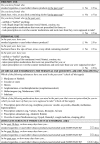Validity of brief screening instrument for adolescent tobacco, alcohol, and drug use
- PMID: 24753528
- PMCID: PMC4006430
- DOI: 10.1542/peds.2013-2346
Validity of brief screening instrument for adolescent tobacco, alcohol, and drug use
Abstract
Background and objective: The National Institute on Alcohol Abuse and Alcoholism developed an alcohol screening instrument for youth based on epidemiologic data. This study examines the concurrent validity of this instrument, expanded to include tobacco and drugs, among pediatric patients, as well as the acceptability of its self-administration on an iPad.
Methods: Five hundred and twenty-five patients (54.5% female; 92.8% African American) aged 12 to 17 completed the Brief Screener for Tobacco, Alcohol, and other Drugs (BSTAD) via interviewer-administration or self-administration using an iPad. Diagnostic and Statistical Manual, Fifth Edition substance use disorders (SUDs) were identified using a modified Composite International Diagnostic Interview-2 Substance Abuse Module. Receiver operating characteristic curves, sensitivities, and specificities were obtained to determine optimal cut points on the BSTAD in relation to SUDs.
Results: One hundred fifty-nine (30.3%) adolescents reported past-year use of ≥1 substances on the BSTAD: 113 (21.5%) used alcohol, 84 (16.0%) used marijuana, and 50 (9.5%) used tobacco. Optimal cut points for past-year frequency of use items on the BSTAD to identify SUDs were ≥6 days of tobacco use (sensitivity = 0.95; specificity = 0.97); ≥2 days of alcohol use (sensitivity = 0.96; specificity = 0.85); and ≥2 days of marijuana use (sensitivity = 0.80; specificity = 0.93). iPad self-administration was preferred over interviewer administration (z = 5.8; P < .001).
Conclusions: The BSTAD is a promising screening tool for identifying problematic tobacco, alcohol, and marijuana use in pediatric settings. Even low frequency of substance use among adolescents may indicate need for intervention.
Keywords: DSM-5; adolescent; substance abuse screen; substance use; substance use disorder.
Copyright © 2014 by the American Academy of Pediatrics.
Figures


References
-
- Substance Abuse and Mental Health Services Administration Results from the 2012 National Survey on Drug Use and Health: Summary of National Findings, NSDUH Series H-46, HHS Publication No. (SMA) 13-4795. Rockville, MD: Substance Abuse and Mental Health Services Administration; 2013
-
- Kaminer Y, Bukstein OG, eds. Adolescent Substance Abuse: Psychiatric Comorbidity and High-Risk Behaviors. New York, NY: Routledge/Taylor & Francis; 2008
-
- Shrier LA, Harris SK, Kurland M, Knight JR. Substance use problems and associated psychiatric symptoms among adolescents in primary care. Pediatrics. 2003;111(6 pt 1). Available at: www.pediatrics.org/cgi/content/full/111/6/e699 - PubMed
-
- Kokotailo P. Physical health problems associated with adolescent substance abuse. NIDA Res Monogr. 1995;156:112–129 - PubMed
Publication types
MeSH terms
Grants and funding
LinkOut - more resources
Full Text Sources
Other Literature Sources
Medical
Miscellaneous

